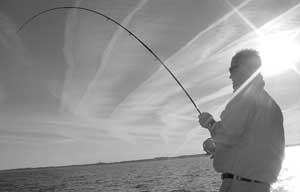
Before Christmas, I was talking to a friend, Jamie McCallum of Dillon, about an upcoming coastal striper fishing trip for January or February. During the past few years, we successfully caught stripers when the specific conditions were right during the winter.
Our best fishing day we caught as many as 18 during an afternoon and couldn’t wait to return. Coastal striper fishing in S.C.’s brackish waters is generally a hit or miss, but we uncover their niche and cashed in on several occasions over the last few years.
Recalling the specifics of stripers’ preferred feeding habitat and conditions would have been impossible without the aid of log books. Records from the previous years document GPS locations where we caught fish, the time of year, the moon phase, the water conditions, the weather, preferred lures and presentations, and general sizes of fish.
Most people would have remembered the trip occurred after Christmas, but would not have remembered what part of January or February it was and they surely couldn’t remember what the water conditions were like during these optimal days.
I’m memory challenged, so I use personal log books to recall important fishing facts. In fact, the last couple years I’ve checked and re-checked my log book for the best days and locations for striper trips. The books also contain the tackle and fishing techniques that worked best with specific water and weather conditions.
After each fishing trip, I make an entry into the log book. I include the date, time fished, weather and water conditions, moon phase with feeding periods, tides fished, locations fished, techniques, tactics, lure choices, fish catches, a brief description of the trip and a brief analysis describing what worked and what didn’t work.
I keep these personalized log sheets organized by fishing location in a three-ring binder. Usually the entry will take anywhere from 5 to 10 minutes to complete.
As painful as it sounds, the first time an angler uses this information with success, the reward will motivate him to always fill out sheets and study them later. With the passage of time, log book data will be extremely valuable and it will make most people better anglers.
Log book data also affords a heap of memorable fishing stories from fishing extravaganzas, but the data is much more valuable and should be used for more than just reminiscing. Fishing is a continual trial-and-error process.
Fish usually tend to repeat behaviors that produce successful results for anglers per the given conditions; i.e., patterns will develop that an angler remembers and may take advantage of during a given day, especially if conditions change.
A pattern will tell an angler which tactic and technique to use not only during the current conditions, but in the future. But first, an angler must compile and analyze his information to understand trends and favorable patterns that utilize techniques that improve catch ratios.
Sometimes more importantly, the data will tell an angler what techniques decrease the chances of catching fish.
I look for consistencies within variables. Where, how, when, and why are questions anglers always should ask before planning a trip. After accumulating enough data, anglers easily should be able to answer these questions.
Commonly, anglers mistake a pattern for a coincidence, and the real pattern might still be unknown. All things happen for a reason, but the reasons for success sometimes are complex.
Anglers should draw a hypothesis based on log entries and test them many times, using the same conditions in order to prove the behaviors to be consistent.
Unfortunately, I waited until 2000 to start recording my fishing trips in a log book and I have completed countless entries for salt and fresh bodies of water.
I got the idea for log books from Doug Hannon, famously known as “the bass professor.” Hannon has proved the successes with his log books to catch hundreds of trophy bass weighing more than 10 pounds in Florida.
Hannon, along with other professional guides and touring pro,s generally will know where, how, and when to catch the most fish, but these guides and pros aren’t necessarily miracle workers. They just spend enormous amounts of time on the water and usually know where the fish are and what they’re eating throughout the year — or during any given day.
More importantly, pros know how to learn from their experiences on the water. Years of trial and error earned them the “pro” title.
Most use log books to document their catches and fishing techniques and they use that information to improve their catches in future years.
When a client pays a guide, he’s also purchasing — in addition to his expertise that day — the guide’s years of experience and reaping the benefits of their log-book data, as well as their proven fishing patterns.
A victorious fisherman is either lucky or has successfully patterned his targeted catch through many trials under specific conditions.
Never rely on luck because (a) luck eventually runs out or (b) you will chalk down your lack of success to bad luck.
Hannon is a proven expert who utilizes log books to perfect his largemouth bass fishing techniques.
To improve your success ratio and consistently catch more fish, log books should always be part of your tackle box.




Be the first to comment